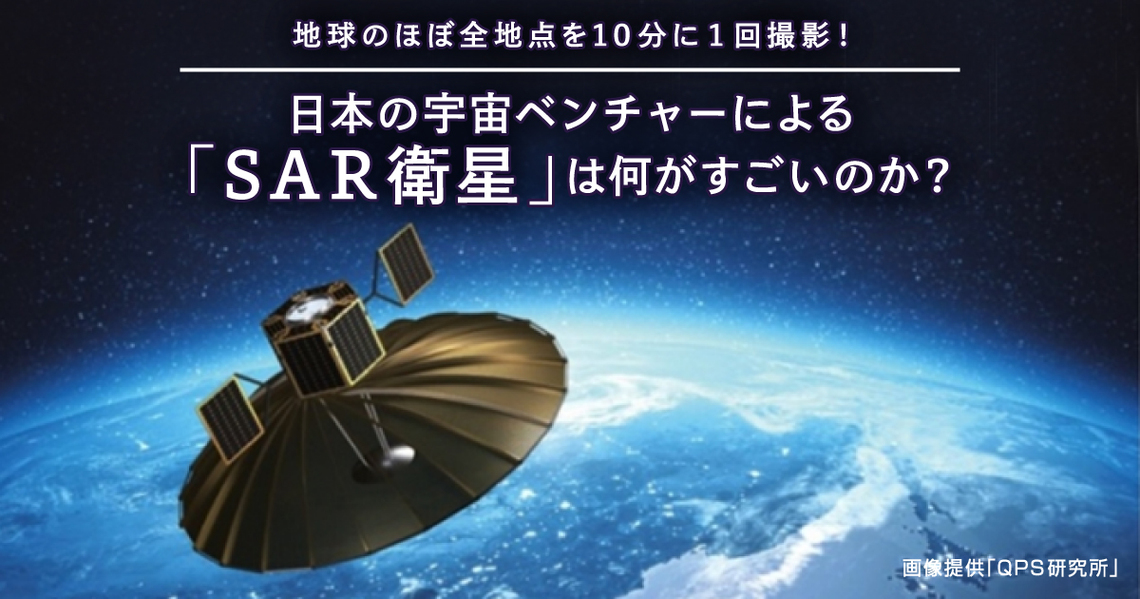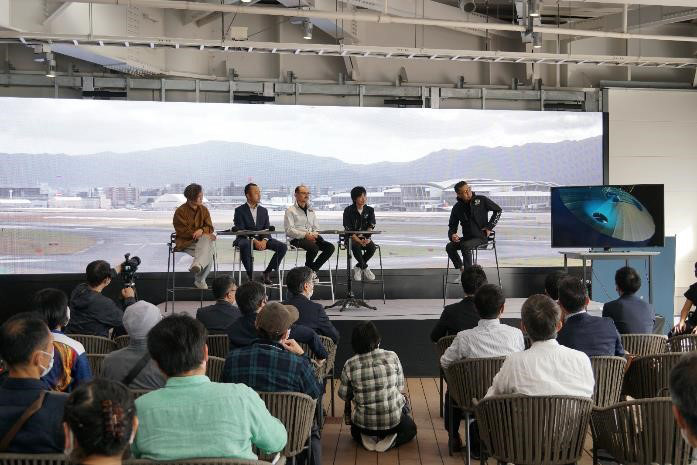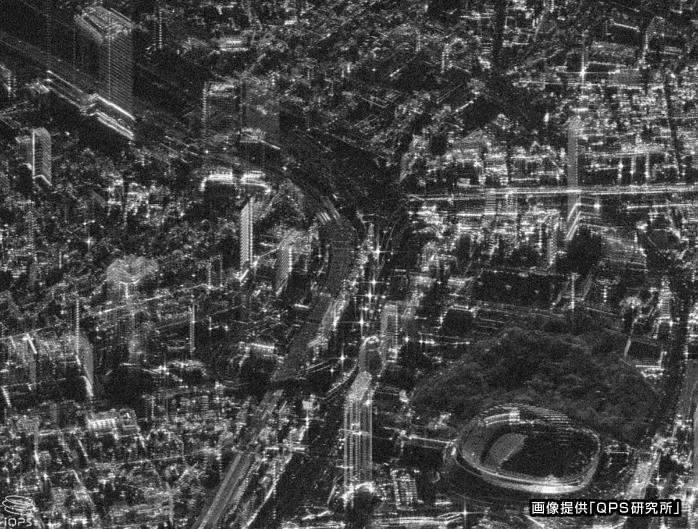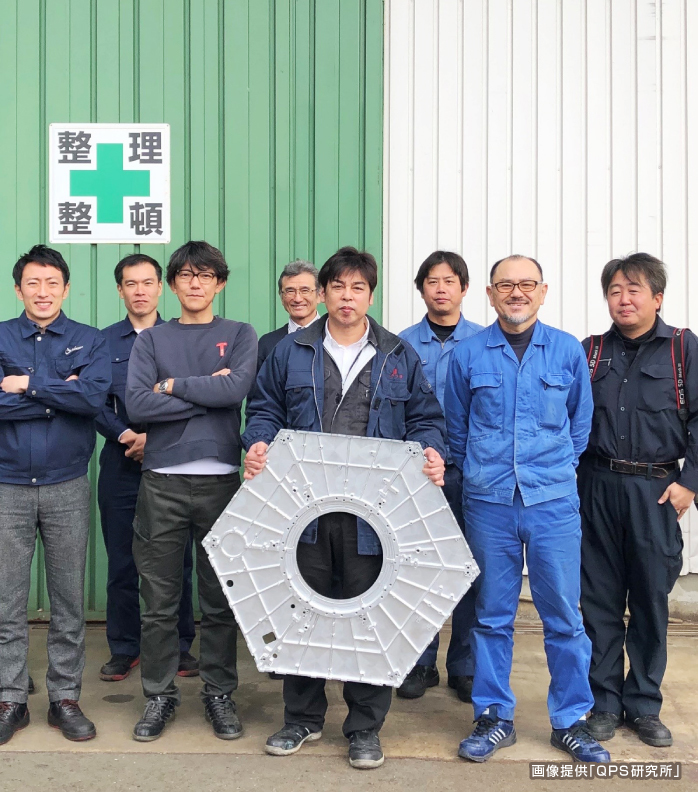Note: This website was automatically translated, so some terms or nuances may not be completely accurate.
Is Space Profitable?! Insights from the Development Frontlines. [Satellite Data Edition]

While many people have an interest in space, in my experience, when the conversation turns to business, it often ends with comments like "That's so dreamy," as if it's someone else's story.
I feel many people hold the fixed notion that "space isn't a profitable field."
Therefore, to help people recognize that space is neither just a dream nor a niche field, but a real business arena, we will introduce two ventures tackling space development in Kyushu and Hokkaido, split into two parts.
This time, we focus on QPS Research Institute in Kyushu. This company is developing a "small SAR satellite" equipped with "synthetic aperture radar" to overcome the weakness of optical sensor satellites: their inability to capture images during bad weather or at night.
By sharing the passion of those on the front lines, we hope to inspire new mindsets among business professionals—thoughts like "Japan is great!" or "Space might actually be profitable!"—and encourage as many as possible to embrace this perspective.
(Text: Dentsu Kyushu Inc., Kei Yamamoto)
From "FUKUOKA SPACE EXPO 2021" (Organized by: Fukuoka Junior Chamber; Supported by: Fukuoka Prefecture, JAXA, etc.)
【Speaker】
Shunsuke Onishi (President & CEO, QPS Research Institute)
Mr. Mutsuo Tōbō (Chairman, Enjin Space Engineering Team)
Mr. Daisuke Yoshihara (Deputy Head, Innovation Group, Kyushu Electric Power ES Business Headquarters)
Masahiro Wakuda (Creative Director/Planner/Copywriter, Dentsu Kyushu Inc.)
<Table of Contents>
▼Observing "Nearly Every Point on Earth" Once Every 10 Minutes on Average. What Can SAR Satellites Achieve?
▼Space for Manufacturing and Human Development. Northern Kyushu Space Cluster
▼To Make Space "Known Territory," Try Doing Things That Seem Meaningless

Observing "nearly every location on Earth" once every 10 minutes on average. What can SAR satellites achieve?

──What kind of satellite is QPS Research Laboratories' SAR satellite?
Onishi: It's a SAR satellite weighing around 100 kg that achieves a resolution of 1 meter or less. A 1-meter resolution means the smallest detectable value is less than 1 meter. We've actually succeeded in achieving 70-centimeter resolution. For example, it can recognize vehicles on the ground from space. We're confident it offers world-class performance for a small satellite.
──What are the key features of the SAR satellite?
Onishi: Since 75% of the Earth is covered by night or bad weather, optical satellites alone have limitations on the times they can capture images. However, SAR satellites use radar technology, allowing them to capture images regardless of weather or time of day.
Weighing only about 100 kg is also key. Launching large satellites into space incurs enormous costs. But because our satellites are lightweight, we can launch many more of them.
Author's note: Satellites, once the exclusive domain of nations and large corporations, have become significantly lighter and cheaper. Japan is still catching up, but overseas, private capital is pouring into these satellite ventures.
──What is the launch status?
Onishi: We launched the first satellite in December 2019 and the second in January 2021. We plan to launch four satellites in 2022. We will continue launching multiple satellites annually, aiming for a 36-satellite constellation(※) starting in 2025.
※Satellite constellation: Integrating multiple satellites to operate as a single system
──How will daily life and society change with the 36-satellite QPS-SAR constellation?
Onishi: We'll be able to observe nearly anywhere on Earth approximately once every 10 minutes. This means you could use your smartphone to check traffic congestion on roads and at facilities, or see lines forming at stores. It's essentially real-time Google Maps.
In the public interest sector, it's defense and security. It will also aid in rapid situation assessment during disasters and infrastructure maintenance. Furthermore, analyzing SAR data can reveal elevation changes on railways down to the millimeter.
Combined with other big data, it can be used to make predictions about the future. It can contribute to the creation of new application services, such as predicting future prices by observing crop growth conditions and predicting business performance based on logistics and traffic volume.
Author's note: Elon Musk's SpaceX has also entered the satellite field and plans to launch more than 10,000 satellites into low Earth orbit. With this momentum, the era of "one satellite per person" may come in the near future, just like smartphones. Underlying this is the shift in players in space development from government to private sector, led by the United States. The public and private sectors are working together to make rockets and satellites cheaper, faster, and lighter.
Space is about building things and building people. Northern Kyushu Space Cluster
![[左]円陣スペースエンジニアリングチーム理事長・當房睦仁氏[右]QPS研究所代表取締役社長・大西俊輔氏](https://cdn.dentsu-ho-dev.com/b579ec41-348f-4d17-946a-6bcf244b1c42/content________08_03.jpg)
──We spoke with Mr. Mutsuhito Tōbō of Enjin Space Engineering Team (*). We understand local companies made significant contributions to the manufacturing of the QPS-SAR satellite.
※Enjin Space Engineering Team... An NPO formed by small and medium-sized manufacturing companies in Kurume City, Fukuoka Prefecture, dedicated to space development. QPS Laboratory's SAR satellite development is carried out in collaboration with over 20 such local partner companies. Chairman Tōbō's primary role is President of Mutsumi Kasei, a fluoropolymer coating processing company.
Toubou: Satellites require both "lightness" and "strength" to withstand rocket vibrations. To resolve these conflicting demands, our members went through trial and error. It was a continuous struggle, but space offers immense reward. People start asking, "Where is that satellite part made?" even about a single screw.
Proving technology works in space means it can handle any environment on Earth. Fukuoka Prefecture has clusters in automotive and tire manufacturing, with diverse technical fields at a globally competitive level. We'll keep honing our skills to stay involved in creating new things.
──Interstellar Technologies founder Takafumi Horie once said, "Space development is the ultimate industrial mixed martial arts." He also noted, "Japan has an automotive supply chain, giving it a competitive edge." That's exactly what this is about.
Onishi: Exactly. While building on existing technologies and know-how, I believe the challenge of space will accumulate techniques and ways of thinking not found in manuals. Challenging space is nothing less than learning from and surpassing the wisdom and tacit knowledge of our predecessors, all while standing on an industrial foundation.
Author's Note: Rockets and satellites cannot be produced through fabless manufacturing (※). Manufacturing requires analog elements like hypothesis testing, teamwork, and fine-tuning. While Japan's space industry is often said to be late to the game, aren't these very areas where Japanese people excel? Space is a frontier that inspires hope, not only for creating new industries but also for defining the Japanese identity in work.
※ Fabless model: A business model where a company does not own factories, concentrating instead on "planning and development" while outsourcing manufacturing. Apple is a prime example .
To make space "something familiar," we try things that seem pointless
──We asked Mr. Wakuda, Creative Director at Dentsu Kyushu Inc. While space utilization will advance, it still feels distant to most people. How can we make space feel more accessible?
Wakuta: For example, opening the roof of Fukuoka PayPay Dome and watching a game from space. Nowadays, baseball games are broadcast live on the internet, which is more accurate, but I think it's important to deliberately do things that are "meaningless" in order to popularize space.
In 2001, Satoshi Takamatsu, who was at Dentsu Inc. at the time, filmed the world's first Pocari Sweat commercial in space. A product that everyone knows went into space. Seventeen years later, Elon Musk launched a real car, the Tesla Roadster, on a rocket.
I imagine Musk didn't want to launch a car; he wanted to sell a dream. I believe that by using familiar things like Pocari Sweat and cars, we need to work to transform the "unknown world" of space into a "known world."
──Do you have any ideas for utilizing space data?
Wakuta: I think data is particularly useful for primary industries such as agriculture and fisheries, especially in Kyushu. Traditionally, agricultural products are determined by the region, such as mikan oranges here and rice there. But with global warming, is that really okay? I wonder if there might be more suitable products and varieties.
Furthermore, there are the same issues as in manufacturing: an aging population of those who pass down experience and a shortage of successors. Utilizing space data and IoT data could help preserve production histories and cultivation methods, and perhaps even create new branded crops.
──Finally, we ask Mr. Yoshihara of Kyushu Electric Power. As a company, how do you intend to utilize space data?
Yoshihara: Kyushu Electric Power envisions using the "eye of space" to assess damage to power facilities like utility poles and transmission towers during disasters. We aim to build a track record of this application and expand it to other power companies nationwide. Additionally, satellite data can replace manual tasks in routine maintenance inspections. As Japan's workforce shrinks, satellites are key to maintaining current service levels.

《After the Seminar》
We are considering what value Dentsu Inc. can provide using the vast amount of data sent by numerous satellites. By predicting the movement of people and goods, we could support decision-making related to clients' supply chains, such as for stores, warehouses, and factories. Furthermore, utilizing it for forecasting crop supply and demand could contribute to proposals for new consumers and reducing food waste.
Initiatives are already underway, such as insurance companies using this data to assess disaster situations for faster claims processing, and construction firms and municipalities monitoring ground shifts to manage project risks. Local governments are also active, with Oita and Fukuoka Prefectures selected as municipalities promoting space business creation. The Dentsu Group is equally committed, launching its own efforts to create new businesses.
In any case, as those tackling development have stated, challenge means "building upon the current foundation, learning from the wisdom of predecessors, and surpassing it." Creating new things and gaining new wisdom. I was reminded once again that new business and monetization lie in the realm beyond that. (Yamamoto)
Was this article helpful?
Newsletter registration is here
We select and publish important news every day
For inquiries about this article
Back Numbers
Author

Yamamoto Kei
Dentsu Kyushu Inc.
Essential Marketer / Producer / Chief Director for Space Business Creation Promotion
Member of the specialized team 'Dentsu Space Lab,' which handles a wide range of activities from collaborations with JAXA to supporting space venture businesses. Around 2005, he met manga artist Leiji Matsumoto, originally from Fukuoka, who was then Chairman of the Japan Space Cadets promoting space education activities. Since then, he has consistently worked under the theme of "making space a reality for business." Even now, alongside diverse client work unrelated to space, he dedicates equal effort to space-related endeavors, actively focusing on marketing support for food and agriculture utilizing satellite data.





